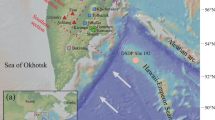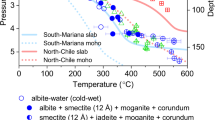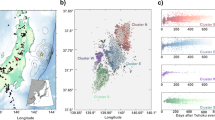Abstract
Water is carried by subducting slabs as a pore fluid and in structurally bound minerals, yet no comprehensive quantification of water content and how it is stored and distributed at depth within incoming plates exists for any segment of the global subduction system. Here we use seismic data to quantify the amount of pore and structurally bound water in the Juan de Fuca plate entering the Cascadia subduction zone. Specifically, we analyse these water reservoirs in the sediments, crust and lithospheric mantle, and their variations along the central Cascadia margin. We find that the Juan de Fuca lower crust and mantle are drier than at any other subducting plate, with most of the water stored in the sediments and upper crust. Variable but limited bend faulting along the margin limits slab access to water, and a warm thermal structure resulting from a thick sediment cover and young plate age prevents significant serpentinization of the mantle. The dryness of the lower crust and mantle indicates that fluids that facilitate episodic tremor and slip must be sourced from the subducted upper crust, and that decompression rather than hydrous melting must dominate arc magmatism in central Cascadia. Additionally, dry subducted lower crust and mantle can explain the low levels of intermediate-depth seismicity in the Juan de Fuca slab.
This is a preview of subscription content, access via your institution
Access options
Access Nature and 54 other Nature Portfolio journals
Get Nature+, our best-value online-access subscription
$29.99 / 30 days
cancel any time
Subscribe to this journal
Receive 12 print issues and online access
$259.00 per year
only $21.58 per issue
Buy this article
- Purchase on Springer Link
- Instant access to full article PDF
Prices may be subject to local taxes which are calculated during checkout



Similar content being viewed by others
References
van Keken, P. E., Hacker, B. R., Syracuse, E. M. & Abers, G. A. Subduction factory: 4. Depth-dependent flux of H2O from subducting slabs worldwide. J. Geophys. Res. 116, B01401 (2011).
Hacker, B. R. H2O subduction beyond arcs. Geochem. Geophys. Geosyst. 9, Q03001 (2008).
Alt, J. C., Honnorez, J., Laverne, C. & Emmerman, R. Hydrothermal alteration of a 1 km section through the upper oceanic crust, Deep Sea Drilling Project Hole 504B: mineralogy, chemistry, and evolution of sea-water-basalt interactions. J. Geophys. Res. 91, 10309–10335 (1986).
Billen, M. I. & Gurnis, M. A low viscosity wedge in subduction zones. Earth Planet. Sci. Lett. 193, 227–236 (2001).
Tatsumi, Y. Migration of fluid phases and genesis of basalt magmas in subduction zones. J. Geophys. Res. 94, 4697–4707 (1989).
Magee, M. E. & Zoback, M. D. Evidence for a weak intraplate thrust fault along the northern Japan subduction zone and implications for the mechanics of thrust faulting and fluid expulsion. Geology 21, 809–812 (1993).
Jarrard, R. D. Subduction fluxes of water, carbon dioxide, chlorine, and potassium. Geochem. Geophys. Geosyst. 4, 8905 (2003).
Korenaga, J. On the extent of mantle hydration caused by plate bending. Earth Planet. Sci. Lett. 457, 1–9 (2017).
Wilson, D. S. in The Cascadia Subduction Zone and Related Subduction Systems. Seismic Structure, Intraslab Earthquakes and Processes, and Earthquake Hazards (eds Kirby, S., Wang, K. & Dunlop, S.) 9–12 (US Geological Survey, Geological Survey of Canada, 2002).
Wada, I. & Wang, K. Common depth of slab-mantle decoupling: reconciling diversity and uniformity of subduction zones. Geochem. Geophys. Geosyst. 10, Q10009 (2009).
Malvoisin, B., Brunet, F., Carlut, J., Rouméjon, S. & Cannat, M. Serpentinization of oceanic peridotites: 2. Kinetics and processes of San Carlos olivine hydrothermal alteration. J. Geophys. Res. 117, B04102 (2012).
Bostock, M. G., Hyndman, R. D., Rondenay, S. & Peacock, S. M. An inverted continental Moho and serpentinization of the forearc mantle. Nature 417, 536–538 (2002).
Audet, P., Bostock, M. G., Christensen, N. I. & Peacock, S. M. Seismic evidence for overpressured subducted oceanic crust and megathrust fault sealing. Nature 457, 76–78 (2009).
Gao, X. & Wang, K. Rheological separation of the megathrust seismogenic zone and episodic tremor and slip. Nature 543, 416–419 (2017).
Preston, L. A., Creager, K. C., Crosson, R. S., Brocher, T. M. & Trehu, A. M. Intraslab earthquakes: dehydration of the Cascadia slab. Science 302, 1197–1200 (2003).
McGary, R. S., Evans, R. L., Wannamaker, P. E., Elsenbeck, J. & Rondenay, S. Pathway from subducting slab to surface for melt and fluids beneath Mount Rainier. Nature 511, 338–340 (2014).
Walowski, K. J., Wallace, P. J., Hauri, E. H., Wada, I. & Clynne, M. A. Slab melting beneath the Cascade Arc driven by dehydration of altered oceanic peridotite. Nat. Geosci. 8, 404–408 (2015).
Horning, G. et al. A 2-D tomographic model of the Juan de Fuca plate from accretion at axial seamount to subduction at the Cascadia margin from an active source OBS survey. J. Geophys. Res. 121, 5859–5879 (2016).
Nedimović, M. R. et al. Upper crustal evolution across the Juan de Fuca Ridge flanks. Geochem. Geophys. Geosyst. 9, Q09006 (2008).
Nedimović, M. R., Bohnenstiehl, D. R., Carbotte, S. M., Canales, J. P. & Dziak, R. P. Faulting and hydration of the Juan de Fuca plate system. Earth Planet. Sci. Lett. 284, 94–102 (2009).
Newman, K. R., Nedimović, M. R., Canales, J. P. & Carbotte, S. M. Evolution of seismic layer 2B across the Juan de Fuca Ridge from hydrophone streamer 2D traveltime tomography. Geochem. Geophys. Geosyst. 12, Q05009 (2011).
Wang, K., He, J. & Davis, E. E. Transform push, oblique subduction resistance, and intraplate stress of the Juan de Fuca plate. J. Geophys. Res. 102, 661–674 (1997).
Govers, R. & Meijer, P. T. On the dynamics of the Juan de Fuca plate. Earth Planet. Sci. Lett. 189, 115–131 (2001).
Han, S. et al. Seismic reflection imaging of the Juan de Fuca plate from ridge to trench; new constraints on the distribution of faulting and evolution of the crust prior to subduction. J. Geophys. Res. 121, 1849–1872 (2016).
Kuster, G. T. & Toksöz, M. N. Velocity and attenuation of seismic waves in two-phase media: Part I. Theoretical formulations. Geophysics 39, 587–606 (1974).
MacKay, M. E. Structural variation and landward vergence at the toe of the Oregon prism. Tectonics 14, 1309–1320 (1995).
Adam, J., Klaeschen, D., Kukowski, N. & Flueh, E. R. Upward delamination of Cascadia Basin sediment infill with landward frontal accretion thrusting caused by rapid glacial age material flux. Tectonics 23, TC3009 (2004).
Booth-Rea, G., Klaeschen, D., Grevemeyer, I. & Reston, T. Heterogeneous deformation in the Cascadia convergent margin and its relation to thermal gradient (Washington, NW USA). Tectonics 27, TC4005 (2008).
Grevemeyer, I. et al. Heat flow and bending-related faulting at subduction trenches: case studies offshore of Nicaragua and Central Chile. Earth Planet. Sci. Lett. 236, 238–248 (2005).
Ranero, C. R., Phipps Morgan, J., McIntosh, K. & Reichert, C. Bending-related faulting and mantle serpentinization at the Middle America trench. Nature 425, 367–373 (2003).
Goldfinger, C. et al. The importance of site selection, sediment supply, and hydrodynamics: a case study of submarine paleoseismology on the northern Cascadia margin, Washington USA. Mar. Geol. 384, 4–46 (2017).
Poli, P., Maksymowicz, A. & Ruiz, S. The Mw8.3 Illapel earthquake (Chile): preseismic and postseismic activity associated with hydrated slab structures. Geology 45, 247–250 (2017).
Wang, K. & Tréhu, A. M. Invited review paper: some outstanding issues in the study of great megathrust earthquakes—the Cascadia example. J. Geodyn. 98, 1–18 (2016).
Audet, P., Bostock, M. G., Boyarko, D. C., Brudzinski, M. R. & Allen, R. M. Slab morphology in the Cascadia gore arc and its relation to episodic tremor and slip. J. Geophys. Res. 115, B00A16 (2010).
Hansen, R. T. J., Bostock, M. G. & Christensen, N. I. Nature of the low velocity zone in Cascadia from receiver function waveform inversion. Earth Planet. Sci. Lett. 337–338, 25–38 (2012).
Peacock, S. M., Christensen, N. I., Bostock, M. G. & Audet, P. High pore pressures and porosity at 35 km depth in the Cascadia subduction zone. Geology 39, 471–474 (2011).
Dragert, H., Wang, K. & James, T. S. A silent slip event on the deeper Cascadia subduction interface. Science 292, 1525–1528 (2001).
Shelly, D. R., Beroza, G. C. & Ide, S. Non-volcanic tremor and low-frequency earthquake swarms. Nature 446, 305–307 (2007).
Audet, P. & Kim, Y.-H. Teleseismic constraints on the geological environment of deep episodic slow earthquakes in subduction zone forearcs: a review. Tectonophysics 670, 1–15 (2016).
Audet, P. & Bürgmann, R. Possible control of subduction zone slow-earthquake periodicity by silica enrichment. Nature 510, 389–392 (2014).
Hyndman, R. D., McCrory, P. A., Wech, A., Kao, H. & Ague, J. Cascadia subducting plate fluids channelled to fore-arc mantle corner: ETS and silica deposition. J. Geophys. Res. 120, 4344–4358 (2015).
Boyarko, D. C., Brudzinski, M. R., Porritt, R. W., Allen, R. M. & Trehu, A. M. Automated detection and location of tectonic tremor along the entire Cascadia margin from 2005 to 2011. Earth Planet. Sci. Lett. 430, 160–170 (2015).
McCrory, P. A., Blair, J. L., Waldhauser, F. & Oppenheimer, D. H. Juan de Fuca slab geometry and its relation to Wadati-Benioff zone seismicity. J. Geophys. Res. 117, B09306 (2012).
Sisson, T. W. & Layne, G. D. H2O in basalt and basaltic andesite glass inclusions from four subduction-related volcanoes. Earth Planet. Sci. Lett. 117, 619–635 (1993).
Ruscitto, D. M., Wallace, P. J., Johnson, E. R., Kent, A. J. R. & Bindeman, I. N. Volatile contents of mafic magmas from cinder cones in the Central Oregon High Cascades: implications for magma formation and mantle conditions in a hot arc. Earth Planet. Sci. Lett. 298, 153–161 (2010).
Plank, T., Kelley, K. A., Zimmer, M. M., Hauri, E. H. & Wallace, P. J. Why do mafic arc magmas contain ∼4 wt% water on average? Earth Planet. Sci. Lett. 364, 168–179 (2013).
Leeman, W. P., Tonarini, S., Chan, L. H. & Borg, L. E. Boron and lithium isotopic variations in a hot subduction zone—the southern Washington Cascades. Chem. Geol. 212, 101–124 (2004).
Leeman, W. P., Lewis, J. F., Evarts, R. C., Conrey, R. M. & Streck, M. J. Petrologic constraints on the thermal structure of the Cascades arc. J. Volcanol. Geotherm. Res. 140, 67–105 (2005).
Wilson, D. S. A kinematic model for the Gorda deformation zone as a diffuse southern boundary of the Juan de Fuca plate. J. Geophys. Res. 91, 10259–10269 (1986).
Miller, N. C. & Lizarralde, D. Finite-frequency wave propagation through outer rise faults and seismic measurements of upper mantle hydration. Geophys. Res. Lett. 43, 7982–7990 (2016).
Canales, J. P. & Carbotte, S. Evolution and hydration of the Juan de Fuca crust and uppermost mantle (International Federation of Digital Seismograph Networks. Other/Seismic Network, 2012); http://dx.doi.org/10.7914/SN/X6_2012
Carbotte, S. M., Canales, J. P., Carton, H. & Nedimović, M. R. Multi-Channel Seismic Shot Data from the Cascadia Subduction Zone Acquired During the R/V Marcus Langseth expedition MGL1211 (2012) (Integrated Earth Data Applications (IEDA), 2014); http://dx.doi.org/10.1594/IEDA/319000
Korenaga, J. et al. Crustal structure of the southeast Greenland margin from joint refraction and reflection seismic tomography. J. Geophys. Res. 105, 21591–21614 (2000).
Dunn, R. A. & Toomey, D. R. Crack-induced seismic anisotropy in the oceanic crust across the East Pacific Rise (9° 30′ N). Earth Planet. Sci. Lett. 189, 9–17 (2001).
McDonald, M. A., Webb, S. C., Hildebrand, J. A., Cornuelle, B. D. & Fox, C. G. Seismic structure and anisotropy of the Juan de Fuca Ridge at 45° N. J. Geophys. Res. 99, 4857–4873 (1994).
Weekly, R. T., Wilcock, W. S. D., Toomey, D. G., Hooft, E. E. E. & Kim, E. Upper crustal seismic structure of the Endeavour segment, Juan de Fuca Ridge from traveltime tomography: implications for oceanic crustal accretion. Geochem. Geophys. Geosyst. 15, 1296–1315 (2014).
Toomey, D. R., Jousselin, D., Dunn, R. A., Wilcock, W. S. D. & Detrick, R. S. Skew of mantle upwelling beneath the East Pacific Rise governs segmentation. Nature 446, 409–414 (2007).
Kodaira, S. et al. Seismological evidence of mantle flow driving plate motions at a palaeo-spreading centre. Nat. Geosci. 7, 371–375 (2014).
Erickson, S. N. & Jarrard, R. D. Velocity-porosity relationships for water-saturated siliciclastic sediments. J. Geophys. Res. 103, 30385–30406 (1998).
Cavin, A., Underwood, M., Fisher, A. & Johnston-Karas, A. In Proc. ODP Sci. Res. (eds Fisher, A., Davis, E. E. & Escutia, C.) Vol. 168, 67–84 (Ocean Drilling Program, 2000).
Hamilton, E. L. Sound velocity-density relations in sea-floor sediments and rocks. J. Acoust. Soc. Am. 63, 366–377 (1978).
Naif, S., Key, K., Constable, S. & Evans, R. L. Water-rich bending faults at the Middle America trench. Geochem. Geophys. Geosyst. 16, 2582–2597 (2015).
McCollom, T. M. & Shock, E. L. Fluid-rock interactions in the lower oceanic crust: thermodynamic models of hydrothermal alteration. J. Geophys. Res. 103, 547–575 (1998).
Schmidt, M. W. & Poli, S. Experimentally based water budgets for dehydrating slabs and consequences for arc magma generation. Earth Planet. Sci. Lett. 163, 361–379 (1998).
Hacker, B. R. & Abers, G. A. Subduction Factory 3: an Excel worksheet and macro for calculating the densities, seismic wave speeds, and H2O contents of minerals and rocks at pressure and temperature. Geochem. Geophys. Geosyst. 5, Q01005 (2004).
Evans, B. W. The serpentine multisystem revisited: chrysotile is metastable. Int. Geol. Rev. 46, 479–506 (2004).
Johannes, W. Experimental investigation of the reaction Forsterite + H2O = Serpentinite + Brucite. Contrib. Mineral. Petrol. 19, 309–315 (1968).
Acknowledgements
This research was funded by the US NSF. We thank the RV M.G. Langseth’s and RV Oceanus’ captains, crews, and technical staffs, and the US Ocean Bottom Seismograph Instrument Pool (OBSIP) managers and technical staff for their efforts, which made possible the success of cruises MGL1211 and OC1206A. We thank K. Wang for his review, which improved the manuscript.
Author information
Authors and Affiliations
Contributions
All authors are co-PIs of the project and contributed to interpretation of results and manuscript writing. J.P.C. conducted the OBS wide-angle seismic data analysis, tomography modelling, and water content calculations, and led the manuscript writing with substantial contributions from all co-authors. S.M.C. was the programme inception and planning leader, and the Chief Scientist for RV Langseth Cruise MGL0812. J.P.C. and H.C. were co-Chief Scientists for RV Oceanus Cruise OC1206A.
Corresponding author
Ethics declarations
Competing interests
The authors declare no competing financial interests.
Supplementary information
Supplementary Information
Supplementary Information (PDF 6094 kb)
Rights and permissions
About this article
Cite this article
Canales, J., Carbotte, S., Nedimović, M. et al. Dry Juan de Fuca slab revealed by quantification of water entering Cascadia subduction zone. Nature Geosci 10, 864–870 (2017). https://doi.org/10.1038/ngeo3050
Received:
Accepted:
Published:
Issue Date:
DOI: https://doi.org/10.1038/ngeo3050
This article is cited by
-
Fluid transport and storage in the Cascadia forearc influenced by overriding plate lithology
Nature Geoscience (2022)
-
Constraining composition and temperature variations in the mantle transition zone
Nature Communications (2022)
-
Cascadia low frequency earthquakes at the base of an overpressured subduction shear zone
Nature Communications (2020)



